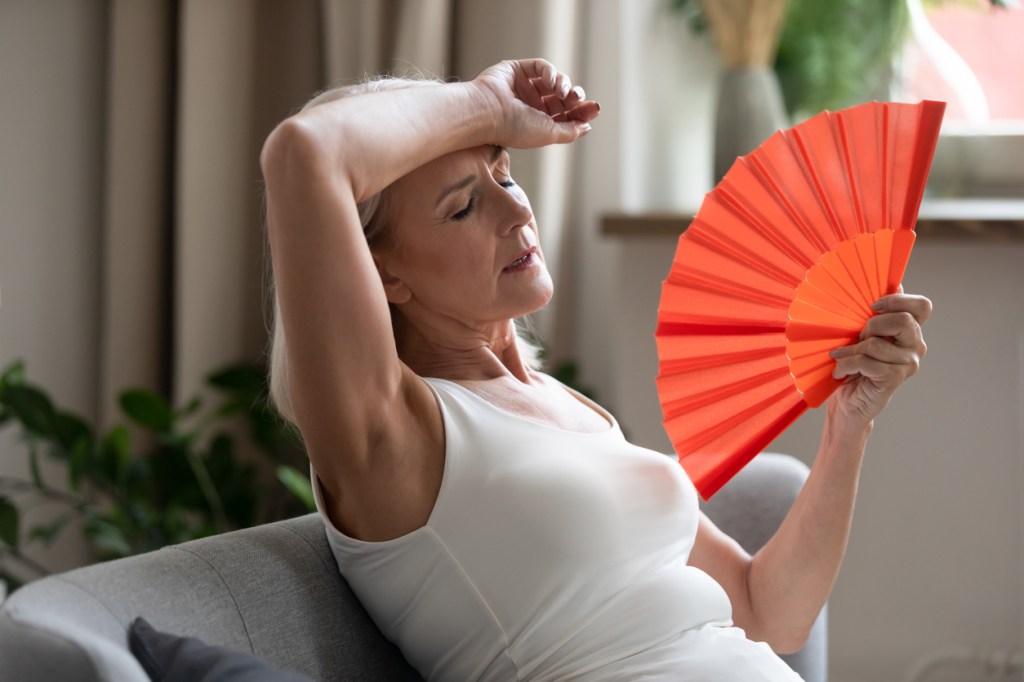How to Manage Hot Flushes During the Menopause

Hot flushes are one of the most common symptoms of the menopause, and many women find them to be uncomfortable and embarrassing. Fortunately, there are many different approaches that you can take to manage your hot flushes and stop them from limiting your lifestyle.
Hot flushes are commonly described as sensations of heat in the face, neck and chest, frequently accompanied by sweating or shivering, and sometimes palpitations – but they vary in their frequency, duration and how much they interfere with daily life and sleep.
Up to 50 per cent of hot flushes have been found to be precipitated or triggered by an identifiable activity or event. There are both internal and external (environmental) triggers. Environmental triggers include the situation you are in, rapid changes in temperature, hot drinks or spicy foods. Caffeinated drinks also generally increase body temperature, as does alcohol, hence women often report more frequent hot flushes after drinking.
Strong emotions have also been shown to trigger hot flushes, particularly negative emotions that activate the stress response. Anger, frustration, stress and often worrying about having a hot flush can activate the fight or flight response which increases core body temperature. Positive emotions, such as excitement, can also increase core body temperature, underlining the importance of managing your emotional wellbeing where possible.
Try Monitoring Triggers
It is worth monitoring potential triggers of hot flushes over the coming weeks and looking out for specific situations or times of day when flushes are more frequent. Normal fluctuations in body temperature linked to our circadian rhythms can also influence this. You may notice that hot flushes occur more frequently at certain times of the day, with no identifiable trigger. Body temperature tends to be at its highest in the late afternoon and early evening and it is common for women to experience hot flushes at home while feeling relaxed because of this.
Practise Calm Breathing
Calm breathing is also known as diaphragmatic breathing (or belly breathing) due to the movement of your stomach as you inhale and exhale. Diaphragmatic breathing is a quick way to activate your body’s relaxation response and lower your body temperature.
Try this exercise:
It can help if you do this exercise lying down to start with.
Place one hand on your stomach or abdomen just below your ribs and the other hand on your chest. There is no need to do this every time you practise but it can be a good way to start out, to ensure you are doing the technique correctly. Without worrying about what your breathing is doing, push your stomach muscles out so that the hand on your stomach moves away from you. Your chest should not move if possible. This movement, however small, is the direction that your stomach should be moving in when you inhale. It shows that your lungs are expanding as would be expected when inhaling, although the aim is not necessarily to take a huge breath, it is more to ensure that your stomach moves out when you inhale. Often if we are asked to take a deep breath in, our stomach can move inwards but this reduces lung capacity, so by keeping your hand on your stomach when you practise, you are ensuring that it is moving in the right direction.
Now practise that movement again, but, as you breathe in, breathe in slowly through your nose, ensuring that your stomach and hand are moving in the same way that they did when you pushed your stomach out. Aim to keep your chest still, but do not worry if it rises when you first start to practise.
Imagine that your lungs are inflating like a balloon, but rather than completely filling your lungs (which can lead to feeling dizzy), the important factor is that your stomach is moving out as you inhale and in as you exhale. You may consciously push your stomach out as you start to practise, but if you are doing the technique correctly, you should hopefully find that it makes this movement by itself. Once you have inhaled, breathe out through your mouth and your stomach should fall back naturally to its original position.
Practise breathing in this way for at least two or three minutes at a time to make sure that you have got the hang of it.
Maintain Your Activities Despite Hot Flushes
Many women report avoiding certain situations that are anxiety provoking during a hot flush, often due to feeling self-conscious, or embarrassed. While in the short term avoidance may be a helpful strategy, in the long term it can undermine confidence about managing flushes, particularly within situations where you are unable to leave. It also means that you reduce your access to situations that you enjoy, which can further reduce mood and confidence.
If you do need to cool down for a few minutes you can always excuse yourself and go outside or to the bathroom/toilet. Workplaces are becoming more aware of the needs of women who are having menopausal symptoms, so find out what facilities might be available, e.g. fans, windows that can open, etc. Just asking the question can raise awareness of the needs of menopausal women amongst employers.
Make Practical Adjustments
Finally, here are some practical tips to make your day-to-day lifestyle easier:
- Wear layers that are easily removable – if a hot flush comes on, it is much easier to cool down quickly.
- If you work in a warm environment, consider the use of fans, open windows or activating the air conditioning, all of which will help keep your core body temperature on the cooler side.
- Wear breathable, cotton clothes.
- At night, consider cotton bedsheets, lighter tog duvets or light blankets and creating a cool sleeping environment. Gel-filled pillow toppers are relatively inexpensive and can help to maintain a cooler body temperature when sleeping.
- Try using water sprays, handheld fans and sipping cold water to reduce temperature once a hot flush has occurred, if environmental triggers are unavoidable.



